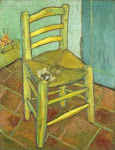It's amazing sometimes what you find by accident. I've been updating lecture sheets for this semester, and I've decided to include a Faith Ringgold quilt in one of my post-WW II lectures for art history survey. A little Googling on Faith Ringgold, and voila! A beautiful work I wasn't familiar with, a story quilt dedicated to noteworthy African-American women of history and none other than Vincent van Gogh.
"The Sunflower Quilting Bee at Arles" (private collection, 74" x 80", click here for an image*) dates from 1991 [the year after the 100th anniversary of Vincent's death, I can't help but notice] and is part of Ringgold's "French Collection." Here, women work together to create a quilt outside the Provencal town of Arles, and the story around the picture tells who they are: Madame C.J. Walker (who invented a hair straightening comb and became a self-made millionaire), Sojourner Truth, Ida B. Wells (who made an expose of the horrors of lynching in South), Fannie Lou Hamer (who braved persecution to register people to vote), Harriet Tubman, Rosa Parks, Mary McLeod Bethune (who founded a college and served as advisor to Truman and FDR), and Ella Baker (who worked to improve housing for poor, jobs, and education). Vincent stands shyly to the right, clutching a bouquet of his beloved sunflowers. In the story, the women aren't sure if they want this white man nearby; they are afraid of him. But ultimately Ringgold makes a connection between the tragic life of van Gogh and the challenges faced by African-American women in history. I personally think Vincent would approve: throughout his life he had great empathy for those in need and a strong sense of social justice.
He'd like the quilt itself too, I think: rich saturated colors reminiscent of van Gogh's work, and if you look closely, that's the Yellow House in the background and to the right, with its distinctive green shutters. The theme of community, of artists working together, was another motif in Vincent's life, although in his case, the desire to create a community of artists in Arles ended sadly.
I'm happy to have 'discovered' this quilt today -- and this week especially, when the book of American history has found itself a brand new page.
*Why am I sending you someplace else to see the picture? Faith Ringgold's work is protected by copyright, as she is a living artist. Mechanically I could put the picture here, but ethically I should not, because I have not received permission from her. I'm assuming the site where I'm sending you has permission to post the image. Better safe than to offend Ms. Ringgold.
Friday, January 23, 2009
Tuesday, January 13, 2009
Running Through History

Many, many congratulations to my fabulous sister Chantel for running the Disney World Marathon this past weekend! (And happy birthday to her today!) This was her first marathon -- what an achievement!
You'll never catch me running a marathon, but as a classicist, I can appreciate the roots of the race in ancient history, specifically the battle of Marathon, which witnessed an overwhelming and surprising victory of the Athenians over the Persians in 490 BC, after the forces of Darius I invaded Greece. According to legend, Pheidippides, the swiftest of foot among the Athenians, ran from Marathon to Athens (26 miles) to announce the victory. "We have won," he said and dropped dead from exhaustion. (He hadn't trained.) Today you can still visit, and I have, the burial mound of the Athenian dead at Marathon.
The marathon was not an event in the ancient Olympics or other festivals -- it was instituted for the 1896 Olympics in Athens -- but ancient games did have footraces, both sprints and longer runs. Women were not allowed to compete in the games in which men competed, but they had their own festivals. The festival of Hera at Olympia, for instance, included footraces for unmarried girls. The winners received olive crowns and the right to dedicate statues with their names on them (a big honor). And in Sparta, athletic training for girls was considered natural. The lovely bronze figurine here (image from the British Museum website, click to enlarge) was probably made in Sparta. She's about 11 centimeters tall, dates from ca. 520-500 BC, and probably decorated a bronze vessel. Her short tunic was the costume for competing female runners, with one shoulder bared to the breast.
Today when people think of ancient Greek athletics, they tend to think of male athletes. But modern running girls share in that history too!
Subscribe to:
Posts (Atom)





